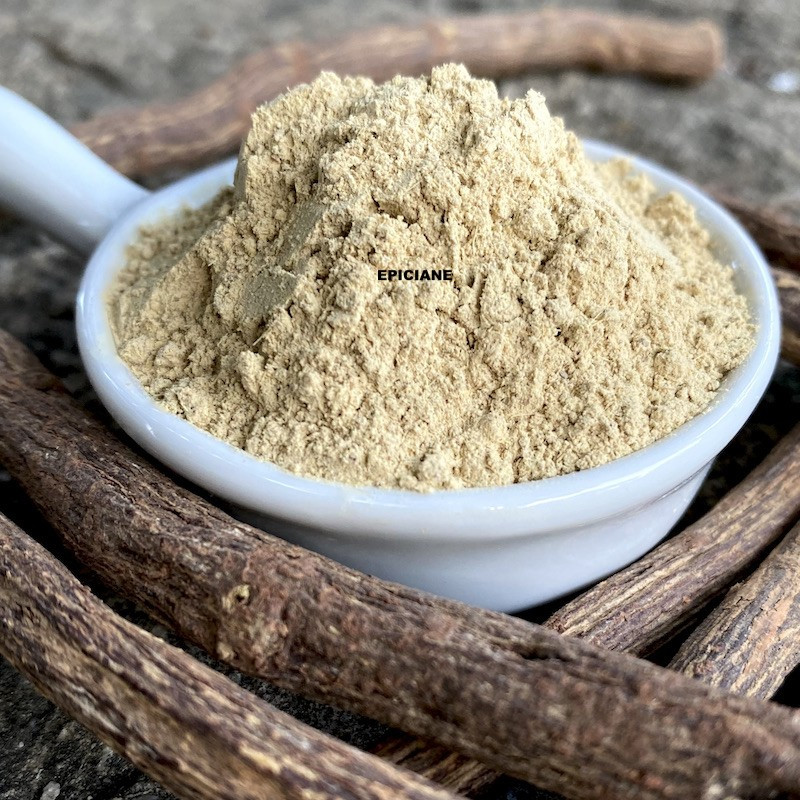
Reference: 112390010


The taste of licorice wood ground into powder is a beautiful harmony between sweetness and a subtle bitterness.
This powder will be delicious in pastries, ice creams, and dessert creams.
 Delivery
Delivery
Mondial Relay
 Returns
Returns
See conditions
 Payments
Payments
100% secure
Produit livré en sachet refermable
Uses in Cooking:
Here, we use what is known as "ratissée" licorice roots, meaning the bark has been removed before grinding into an extremely fine powder. This licorice powder has a particularly mild taste, without the pronounced bitterness of the bark, offering a delightful mix of sweetness with a marked sugary sensation.
Licorice powder pairs beautifully with vanilla, which softens its flavor even more, as well as with mint, honey, caramel, and even coconut. It's perfect for flavoring yogurts, ice creams, custards (like crème anglaise), biscuits, other pastries, and even some jams. You can mix it directly into your preparation, where it will instantly infuse flavor without leaving a trace.
Licorice root is also used in herbal medicine, confectionery, and beverage production. In fact, some still make a kind of pastis by macerating licorice and a few other spices in alcohol with added sugar. This drink is delicious and completely natural, although it should be consumed in moderation due to its alcohol content.
Licorice is also a true delight in infusions (chopped licorice is preferable for this), either on its own or added to tea, mint, or even medicinal herbal teas to enhance their flavor! You can also add it to the cooking juices of certain white meats like chicken or guinea fowl (in moderation) or even use it in jams like melon jam.
Many people chew licorice sticks, especially children, as well as those trying to quit smoking, often without realizing they're benefiting from its powerful medicinal properties! Chewing on licorice sticks, particularly in winter, can be a great protection against respiratory infections and winter viruses.
Licorice is tonic, digestive, and soothing for the throat. It is still recommended today for colds, bronchitis, and sore throats due to its expectorant and cough-suppressing properties. However, be cautious: some of its active compounds can raise blood pressure, cause edema, and lower potassium levels in the body. Excessive daily consumption of licorice or products containing it can lead to serious health issues, and it is strongly discouraged for people with high blood pressure.
Who am I?
Origin: Turkey
Scientific name: Glycyrrhiza glabra
Common names: Licorice, sweetwood, caliche (in Belgium), reegalisse
Licorice is a perennial herbaceous plant from the Fabaceae family, growing in bushes between 1m and 1.5m tall. Its aromatic roots, long rhizomes, are harvested for consumption. The plant has light green leaves similar to those of acacias and produces small blue to violet flowers in upright clusters. The fruit is a small, flat pod, 2 to 3 cm long, containing numerous seeds. Licorice originates from southern Europe, particularly around the Mediterranean.
Licorice thrives in rich, moist soils and warm climates, such as those found in its Mediterranean homeland, as well as in the southern U.S., the Middle East, and North Africa, where it has long been introduced. When it thrives, licorice can become very invasive—much like a weed—even after uprooting, as just one fragment of root left in the ground can sprout a new plant!
The name "licorice" is used for both the plant and its roots. For the roots, both masculine and feminine forms are used interchangeably, while the plant itself is always referred to in the feminine form.
A Little History:
Licorice was already known to the ancient Greeks and Romans, who used it to clear the voice. It is also said that the Pharaohs appreciated it as well.
In the 13th century in Montpellier, a small candy called "grisette" was created by combining licorice and honey. Around this time, licorice began to be cultivated around the Mediterranean, whereas it had previously only been wild. Later, it was mixed with roasted couch grass root to prepare a drink known as "hospitalière," which was often found on hospital bedside tables.
In the 15th century, after Jacques Coeur brought gum arabic from the Orient, leading to the invention of chewing gum, licorice began flavoring these confections, which would later be called bonbons.
By the 18th century, the "coco" trend emerged in Paris—a drink made from licorice macerated in lemon water. It was sold throughout Paris, even on the streets. Around the same time, people were consuming "cachous," a mix of licorice and areca nut, a mild stimulant.
Finally, it is said that Napoleon Bonaparte became addicted to licorice after consuming it excessively, as it helped alleviate his gastric problems.
Data sheet
Reference: 112390010
Reference: 108017302
Reference: 7N7525705
Reference: 050721
Reference: ecorceorangeamere
Reference: badianeM
Reference: EPI230204
Reference: 10N7738802
Reference: fevetonka
Reference: L0001204690
Reference: EPI2301010
Reference: SPW06600
Reference: 10M6821604
Reference: 6470
Reference: cardamomeM
Reference: speculos
Reference: bergamote
Reference: vanillebourbonE
Reference: cardamomeverteE

The taste of licorice wood ground into powder is a beautiful harmony between sweetness and a subtle bitterness.
This powder will be delicious in pastries, ice creams, and dessert creams.